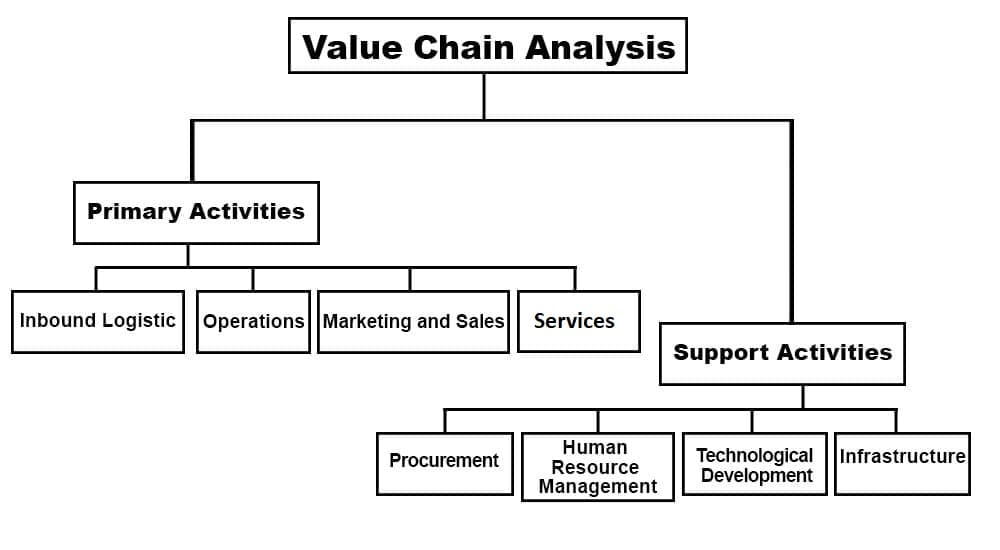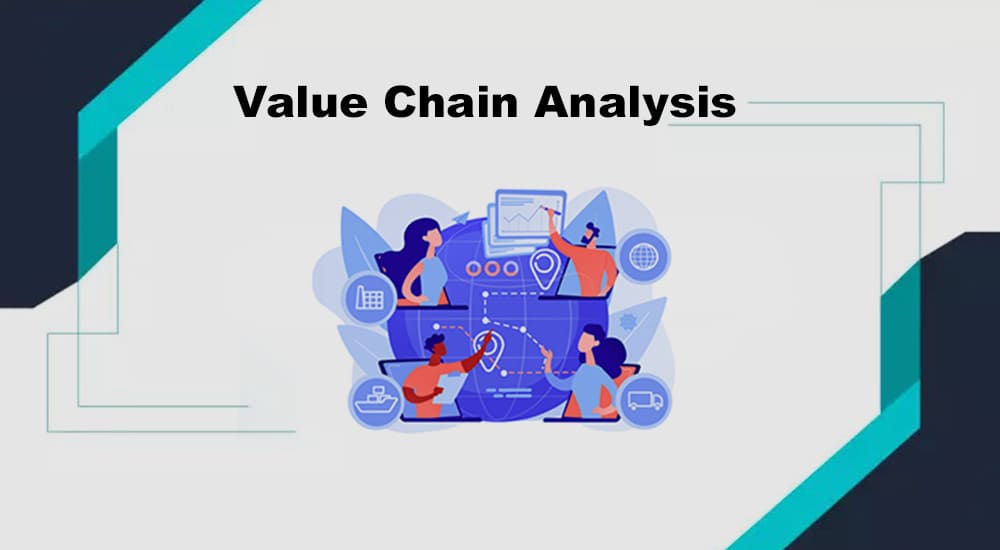Every business aims to make a profit while offering value to consumers. They are always looking for ways to gain a competitive edge. Staying ahead helps them grow their business and brand.
Value can ensure that consumers repeatedly buy from the business among many alternatives.
So, how can a business gain a competitive advantage, offer value, and earn profit?
They can do so through value chain analysis.
In today’s blog post, we will learn value chain analysis, but before that, let us have a quick look at the value chain.
What Is A Value Chain?
A value chain comprises internal activities and processes that a business carries out to transform products from their raw state to their finished state. It can include multiple product life cycle phases, such as design, production, marketing, distribution, after-sales services, etc.
What Is Value Chain Analysis?
In 1985, Michael Porter, a professor at Harvard Business School, coined the phrase “Value Chain Analysis.” In his book “Competitive Advantage: Creating and Sustaining Superior Performance,” he introduced the basic concept of value chain analysis and explained how businesses can identify primary and supporting activities and create value for their consumers.
Porter explained that business activities can be categorized into two groups: primary and support activities. If a product offers more value than its cost, the business will generate a profit.
*Profit Margin = Value Created – Cost of Creating Value
In value chain analysis, a business identifies primary and support activities that add value to the product and then finds activities to minimize costs.
In other words, value chain analysis calculates the cost of all activities required to build a product. The company can use the information to increase profit through cost-saving (cost leadership) or product differentiation (competitive differentiation).
Understanding the Value Chain Analysis Tool
Value chain analysis is a useful tool for businesses to work out how they can generate the highest level of value for their customers. With this tool, organizations can analyze their business activities and pinpoint the most valuable activities to improve in order to increase the market edge.
The value chain analysis tool helps businesses weigh how each step in the production process adds or subtracts value from the product or service.
Businesses can use value chain analysis to boost their profits in three different ways:
- Cost Leadership: This strategy helps businesses cut the cost of production and streamline processes to boost productivity and increase profit. Here, a business produces a product of the same quality as the competition but sells it at a lower price. This is a good strategy, but competitors can overshadow it with new product launches. Cost leadership is not a long-term product pricing strategy.
- Competitive Differentiation: Through value chain analysis, businesses can increase value by offering a unique and high-quality product or service. Here, they can show how their product or service is different from the competitors. This differentiates businesses from the competition, increases their value to their consumers, and helps them stand out from the crowd. Product differentiation involves having a unique product or service that is not available to competitors. These special features may include higher quality, extra features, ease of use, etc.
- Focus: This strategy is also known as niche or segmentation strategy, and it focuses on a particular group of audience. Since the audience is small, businesses can offer better products and unique services.
Using the Value Chain Analysis Tool
The value chain analysis tool helps the business determine the best competitive strategy. Porter’s value chain analysis tool is the most popular value chain analysis tool, and it divides operations into two categories: primary activities and support activities.

Primary Activities
Businesses require five activities to create a product or service, promotion and maintenance.
These activities are:
- Inbound Logistics: These activities help acquire raw materials and resources for product creation.
- Operations: These activities convert raw material to finished products.
- Outbound Logistics: These activities help deliver the finished products to consumers, including storage, distribution, and delivery.
- Marketing and Sales: These activities communicate with the target audience and create product awareness.
- Services: These activities are related to after-sales support and other services to maintain the product value.
Support Activities
Support activities provide support to primary activities and assist them in adding value to customers.
Support activities can be categorized into four groups:
- Procurement: Procurement helps businesses purchase raw materials and acquire resources to build the product.
- Human Resource Management: These activities help hire human resources and ensure that manpower has the required skills to build the product.
- Technological Development: These activities help businesses deal with the latest technology in business processes.
- Infrastructure: Infrastructure includes the systems to support the business, including physical infrastructure, management system, IT, legal, etc.
Competitive Advantage Types
Why does a consumer choose one product over another? Why would they spend more money on a product when other cheaper options are available?
The reason is a competitive advantage.
A competitive advantage allows businesses to outperform their competition. It lets a business achieve better margins than its competition.
There are three types of competitive advantage: cost leadership, differentiation, and focus.
Value Chain Analysis Example
Value chain analysis lets organizations scrutinize their activities and provides them with opportunities to improve processes.
Case Study: Value Chain Analysis for McDonald
Now, we will see how value chain analysis helped McDonald’s achieve their goal of providing consumers with affordable food.
McDonald’s Primary Activities
McDonald’s sources raw materials from a selected list of low-cost suppliers for inbound logistics.
McDonald’s uses franchises for its operations. Its restaurants are focused on counter-services, self-services, and drive-through services. Its marketing is focused on social media, media and print advertising, and billboards, and it provides training for its employees to improve customer service.
McDonald’s Support Activities
McDonald’s infrastructure includes executives and zonal presidents that oversee the businesses’ operations. Its HR practices include salaries and tuition assistance for college-going staff. The restaurant uses a digital procurement firm to manage global suppliers.
The Steps Required in a Value Chain Analysis
A value chain analysis requires five steps:
STEP 1: Evaluate All Value Chain Activities
The first step is defining primary and supporting activities. It is not enough to identify each primary and support activity; details are also required.
STEP 2: Determine the Cost of Each Value Chain Activity
Calculate the value of each value chain component, including the primary and support activities. Afterward, businesses weigh the component cost against its value and determine the required improvements.
Brainstorm and find how each process adds value to the product and business.
STEP 3: Identity What the Customers Perceive as Value
Consumers connect value with the product price. Businesses must understand what consumers consider beneficial and how they make purchasing decisions. A business can establish user purchasing patterns by collecting and analyzing user data.
This data helps the marketing team create better marketing campaigns.
Personal networks also influence the purchasing habit of a person; their friends, family, and social groups have a tremendous impact on what they purchase. Therefore, knowing customers’ needs and their social ecosystem is vital to a business.
STEP 4: Examine the Competitor’s Value Chains
Businesses analyze the market and competition to determine the value. In the absence of competitors’ operational data and infrastructure, businesses can use benchmarks. This is called competitive benchmarking.
Businesses can adopt strategic benchmarking, process benchmarking, or performance benchmarking.
In strategic benchmarking, a business compares their high-level strategy to their competition to see what they are doing differently.
In process benchmarking, a business compares its process structure with the competition.
In performance benchmarking, a business compares outcomes while factoring in social media performance, organic traffic, revenue, reviews, ratings, etc. This competitor-insight loop by McKinsey helps businesses learn about their rival program management and decision-making processes.
STEP 5: Decide on a Competitive Advantage
Now, businesses can see the complete process, their effect on profit, and the areas for improvement.
Value chain analysis helps businesses know where to adjust processes to provide the utmost value to customers. They can begin with small improvements that yield big results. It provides insight to businesses that helps them select strategies to stay ahead of the competition.
Conclusion
Value chain analysis is a powerfully strategic business tool that helps boost business performance, uncover hidden pitfalls that should be eliminated, and highlight strategies that can be improved.
This helps a business achieve its aim of launching more products, addressing customer needs more appropriately, earning more profit, and staying ahead of the competition. Businesses can use value chain analysis to uncover opportunities that help them grow in profit, customer base, and value.
Without value chain analysis, it is difficult for a business to find points in its production process where it can lower costs and streamline processes. Value chain analysis helps a business identify wasteful and unnecessary activities in the production process, clean up the production activities, and provide more value for clients.
